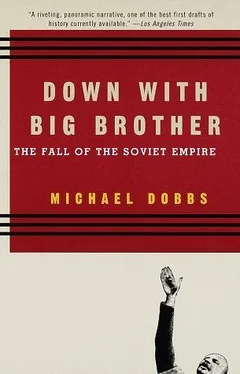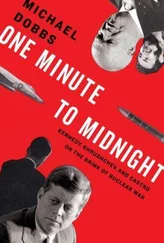Although Karadžić denied issuing such instructions, he used similar language in my presence. He interrupted our conversation several times to take telephone calls from regional SDS chiefs and discuss plans for full-scale mobilization. “The destiny of Serbia is at stake,” he screamed down the phone. “This is our historic hour. We must act now.”
Turning his attention to me, he laid out his own idiosyncratic version of Bosnian history. “The Muslims are trying to dominate Bosnia. They want to create an Islamic state here, but we Serbs are not going to let them. You cannot force Christians to live in a Muslim state. Look at what happened in Lebanon. The Bosnian Muslims are really Serbs who were forced to convert to Islam, when the Turks were here. They have a very high birthrate. They are waiting until they make up fifty percent of the population, and then they will proclaim their Islamic state. I don’t understand why America is supporting this anti-Serb coalition.”
I asked him if he would agree to some kind of loose confederation between Bosnia and Serbia, an idea then under discussion. He shook his pompadour of scruffy gray hair in a vigorous no.
“We will never agree to this. A confederation is not a stable type of state. Attempts to create a confederation can only end by war or by disintegration. Probably both. They cannot take our territory.”
The kind of state Karadžić had in mind became clear when he produced a map purporting to show that many Bosnian towns with majority Muslim populations were really “Serb.” This was at the height of the so-called war of the maps, when every ethnic group was making absurd territorial claims. In retrospect, however, Karadžić’s map was a remarkably farsighted document. This was more or less what Bosnia was to look like in a year’s time, after hundreds of thousands of Muslims had been chased from their homes by “ethnic cleansing.”
LEAVING KARADŽIĆ’S HEADQUARTERS ON that golden fall afternoon, I felt a stab of nostalgia for a city and a way of life that seemed threatened with extinction. Sarajevo, built along a narrow river valley, surrounded by high mountains, was a seductive blend of East and West, old and new. The slender minarets of dozens of mosques dotted the hillsides, next to squat Orthodox churches and solid Austro-Hungarian buildings like the post office and Bosnian presidency. The cobblestoned old town, the Baš-čaršija, was a blaze of oriental bustle and color. Farther along the Miljačka Valley were the modern skyscrapers of the Communist era, which would have been eyesores in many other places but added to the city’s eclectic charm. Full of coffeehouses and nightclubs, Sarajevo was a tolerant, hedonistic city, echoing with gaiety and laughter.
It was in Sarajevo that I had first felt the distant rumbling of the political earthquake that was to sweep away the old order. It was May 4, 1980, a Sunday. I entered the city at dusk, having just driven up from Dubrovnik, through the Neretva Valley. The traffic seemed unusually chaotic, cars rushing in all directions, ignoring the most elementary traffic regulations. When I checked into the Europa Hotel in the Baš-čaršija, the receptionist was crying. He told me that Tito had died less than an hour before. Like many people in Sarajevo, he was terrified by the thought of what would happen to his country now that the man who had held it together for thirty-five years was gone. The television in the corner of the reception was showing old newsreel footage of Tito threatening to deliver a decisive rebuff to any invader. “In the same way we fought the Germans in the war, we were ready to fight in 1948, we are ready to fight now, and we will be ready to fight in the future too, when I am gone,” the old marshal was declaring.
Bosnia had remained at peace for more than a decade after Tito’s death, but its luck was now running out. The threat was coming not from without—as Tito had suggested—but from within. The legitimate government was attempting to deal with a fifth column, right in its midst, and was too weak to defend itself effectively. The Serbian nationalists in Sarajevo and Belgrade had resorted to a proven technique of aggression. As I walked away from my meeting with Karadžić, I was reminded of the situation in Czechoslovakia, prior to the Nazi takeover in 1938. By whipping up the nationalist sentiment of the German population in the Sudetenland, the Nazis were able to occupy the entire country with very little resistance. The rest of the world stood by and did nothing.
It did not take a great deal of imagination to predict the fate that awaited Sarajevo in the event of war. It already had a name, Vukovar.
VUKOVAR
November 19, 1991
WHEN THE YUGOSLAV ARMY and Serb militiamen finally entered Vukovar after shelling it mercilessly for eighty-seven days, they discovered a nightmarish wasteland of death and destruction. Bullet-riddled bodies littered the rubble-strewn streets; stray dogs wandered amid the burning apartment buildings; burned-out cars and tanks lined roads strewn with land mines; survivors emerged blinking into the sunlight from their cellars and basements, crying in horror at the scene of devastation around them. Not a single wall, door, or roof seemed to have escaped the downpour of artillery shells, bombs, and bullets. Even the trees had been chopped to pieces.
Before the war began, Vukovar was a charming town on the Danube River, known for its baroque churches and large shoe factory. Now it resembled a picture of Dresden after the Allied bombing campaign. Europe had not witnessed destruction like this since the Second World War. The Serb victors spoke of “liberating” Vukovar from the Croatian “fascists,” but there was precious little left to “liberate.” If there was ever a case of destroying a city in order to save it, this was it.
For Croats, Vukovar had become a symbol of their determination to resist Serbian aggression. It was their Stalingrad. For weeks Radio Vukovar had been broadcasting messages from its weak UHF transmitter: “Vukovar is still fighting. Vukovar has not fallen.” The town was defended by some fifteen hundred poorly armed policemen and volunteers. Yet for almost three months, they held out against an attacking force of some twenty thousand men, supported by tanks, artillery, and aircraft. When the JNA sent a column of tanks into the suburb of Borovo Naselje in mid-September, it was decimated by Croat militiamen, using shoulder-held grenade launchers. Unable to capture Vukovar in a ground assault, the JNA changed tactics and pulverized the town from the air with rockets, mortars, and bombs. Forced to take refuge in the basements, the townspeople drank rainwater and ate stale crusts of bread in order to survive. Many died for lack of medical care.
Atrocities were committed on both sides. Rival commanders thought nothing of executing civilians for suspected treachery or merely because of their ethnic origin. In addition to the thousands of people who lost their lives as a result of the shelling, hundreds simply disappeared. Fighting was particularly fierce around the Borovo shoe factory, on the northern approaches to the town.
When the JNA and Serb militia groups closed in on Vukovar in early November, the Croat defenders fought for every house and every cellar, until they ran out of ammunition. Several hundred defenders managed to escape across the cornfields. Several hundred others surrendered to the army and were reasonably well treated. Croat fighters who were captured by Serb irregulars were often executed on the spot, sometimes in full view of the foreign journalists who had been permitted to witness the final “liberation” of the city. 9
By the time their ordeal was finally over, both Serb and Croat survivors were too shell-shocked to display much relief. “My life has no meaning anymore,” said Marina Rodić, a Croat woman, who lost her husband and her son during the fighting. “Nobody won in Vukovar, we all lost,” said Milan Bosnić, a Serb who spent sixty-three days in a cellar. 10
Читать дальше












